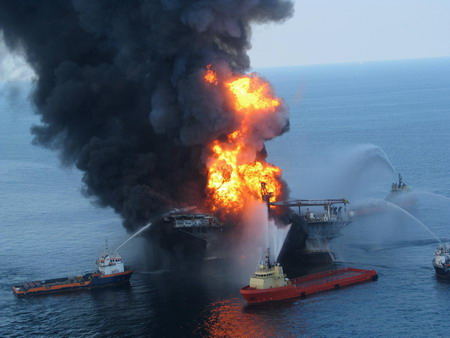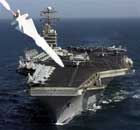Asia-Pacific
Burning oil rig sinks, setting stage for big spill
(Agencies)
Updated: 2010-04-23 10:15
 |
Large Medium Small |
|
|
NEW ORLEANS: A deepwater oil platform that burned for more than a day after a massive explosion sank into the Gulf of Mexico on Thursday, creating the potential for a major spill as it underscored the slim chances that the 11 workers still missing survived.
The sinking of the Deepwater Horizon, which burned violently until the gulf itself extinguished the fire, could unleash more than 300,000 gallons (1,135,600 liters) of crude a day into the water. The environmental hazards would be greatest if the spill were to reach the Louisiana coast, some 50 miles (80 kilometers) away.
|
||||
Carolyn Kemp said her grandson, Roy Wyatt Kemp, 27, was among the missing. She said he would have been on the drilling platform when it exploded.
"They're assuming all those men who were on the platform are dead," Kemp said. "That's the last we've heard."
Jed Kersey said his 33-year-old son, John, had finished his shift on the rig floor and was sleeping when the explosion happened. He said his son told him that all 11 missing workers were on the rig floor at the time of the explosion.
An alarm sounded and the electricity went out, sending John Kersey and other workers scurrying to a lifeboat that took them to a nearby service boat, his father said.
"They waited for as many people as they could," Jed Kersey said. He said his son wasn't ready to talk publicly about his experience.
As the rig burned, supply vessels shot water into it to try to keep it afloat and avoid an oil spill, but there were additional explosions Thursday. Officials had previously said the environmental damage appeared minimal, but new challenges have arisen now that the platform has sunk.
The well could be spilling up to 336,000 gallons (1,271,860 liters) of crude oil a day, Coast Guard Petty Officer Katherine McNamara said. She said she didn't know whether the crude oil was spilling into the gulf. The rig also carried 700,000 gallons (2,649,700 liters) of diesel fuel, but that would likely evaporate if the fire didn't consume it.
Coast Guard Rear Adm. Mary Landry said crews saw a 1-mile-by-5-mile (1.5 kilometer-by-8 kilometer) rainbow sheen with a dark center of what appeared to be a crude oil mix on the surface of the water. She said there wasn't any evidence crude oil was coming out after the rig sank, but officials also aren't sure what's going on underwater. They have dispatched a vessel to check.
The oil will do much less damage at sea than it would if it hits the shore, said Cynthia Sarthou, executive director of the Gulf Restoration Network.
"If it gets landward, it could be a disaster in the making," Sarthou said.
Doug Helton, incident operations coordinator for the National Oceanographic and Atmospheric Administration's office of response and restoration, said the spill is not expected to come onshore in the next three to four days. "But if the winds were to change, it could come ashore more rapidly," he said.
At the worst-case figure of 336,000 gallons a day, it would take more than a month for the amount of crude oil spilled to equal the 11 million gallons (40 million liters) spilled from the Exxon Valdez in Alaska's Prince William Sound.
The well will need to be capped off underwater. Coast Guard Petty Officer Ashley Butler said crews were prepared for the platform to sink and had the equipment at the site to limit the environmental damage.
Oil giant BP, which contracted the rig, said it has mobilized four aircraft that can spread chemicals to break up the oil and 32 vessels, including a big storage barge, that can suck more than 171,000 barrels of oil a day from the surface.
Crews searching for the missing workers, meanwhile, have covered the 1,940-square-mile (3,120-kilometer) search area by air 12 times and by boat five times. The boats searched all night.








